BA7020 International Money and Finance: Current Account Deficit Essay
VerifiedAdded on 2023/01/07
|8
|2427
|39
Essay
AI Summary
This essay critically examines the statement that a current account deficit is always a sign of weakness in international finance. It begins by defining the current account and its components, explaining how it reflects a nation's transactions with the rest of the world, including trade in goods and services, investment income, and net transfers. The essay then delves into the factors influencing the current account, such as trade balance, cyclical trends, and exchange rates, and discusses how these elements can lead to a deficit. It explores arguments both supporting and contradicting the notion that a current account deficit signifies economic weakness, considering the impact on borrowing, investor confidence, and currency values. The essay also highlights situations where a deficit might not indicate weakness, such as when it's driven by foreign investment, or when external debts fund lucrative domestic investments. Furthermore, the essay considers the positive aspects of a deficit and concludes that the statement is not always correct, as the impact of a current account deficit depends on various factors like foreign investment and the overall economic context. The report also provides an overview of how nations can address and manage current account deficits to maintain economic stability and growth.
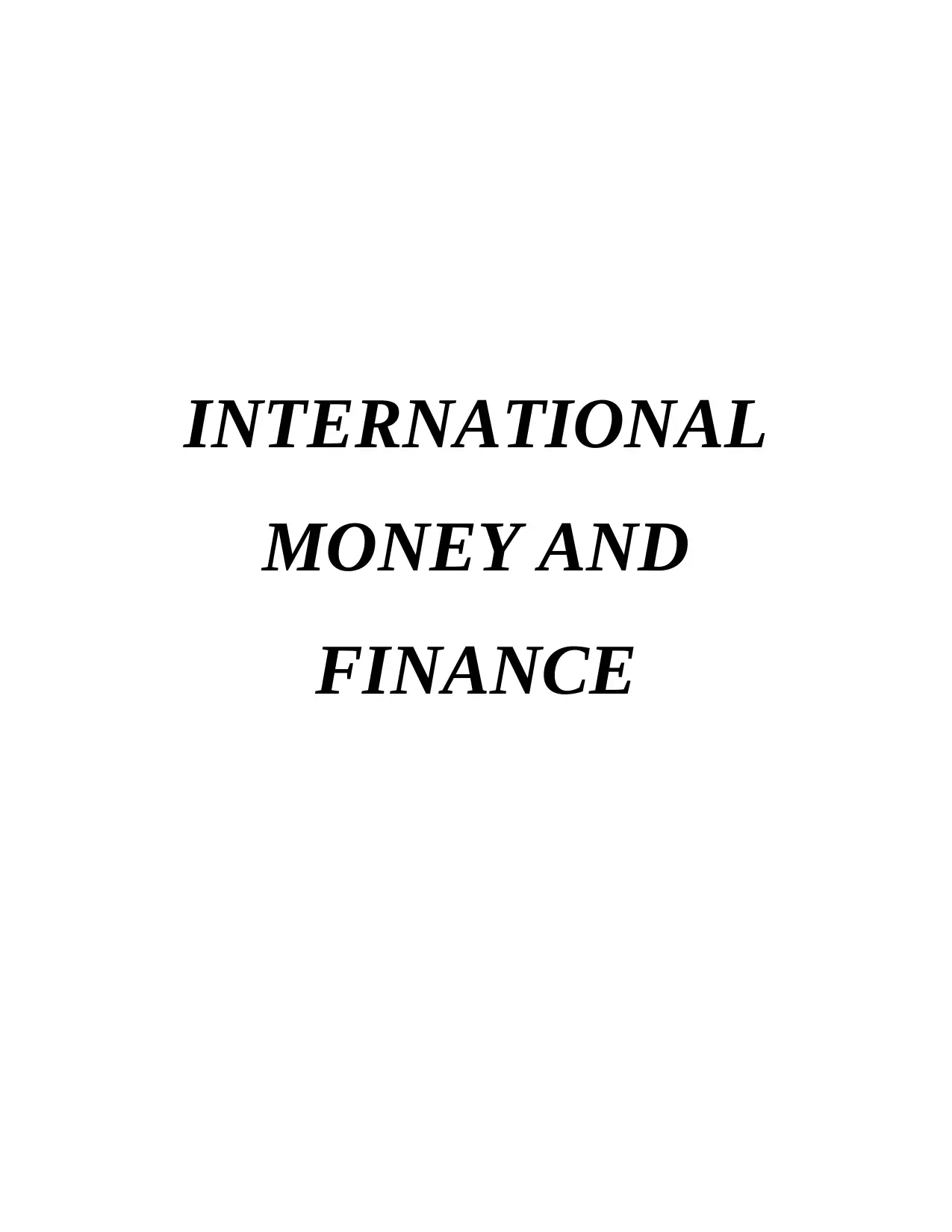
INTERNATIONAL
MONEY AND
FINANCE
MONEY AND
FINANCE
Secure Best Marks with AI Grader
Need help grading? Try our AI Grader for instant feedback on your assignments.
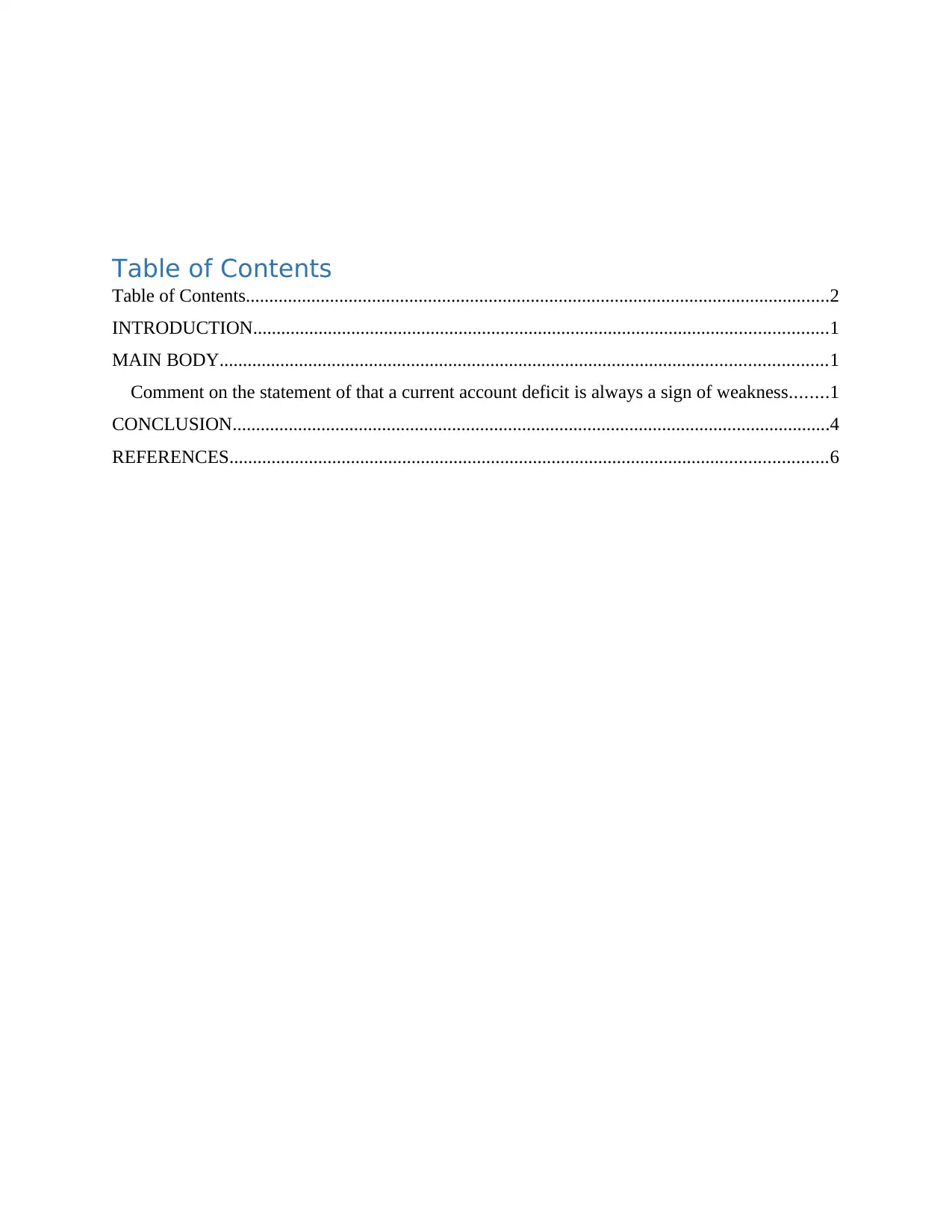
Table of Contents
Table of Contents.............................................................................................................................2
INTRODUCTION...........................................................................................................................1
MAIN BODY..................................................................................................................................1
Comment on the statement of that a current account deficit is always a sign of weakness........1
CONCLUSION................................................................................................................................4
REFERENCES................................................................................................................................6
Table of Contents.............................................................................................................................2
INTRODUCTION...........................................................................................................................1
MAIN BODY..................................................................................................................................1
Comment on the statement of that a current account deficit is always a sign of weakness........1
CONCLUSION................................................................................................................................4
REFERENCES................................................................................................................................6
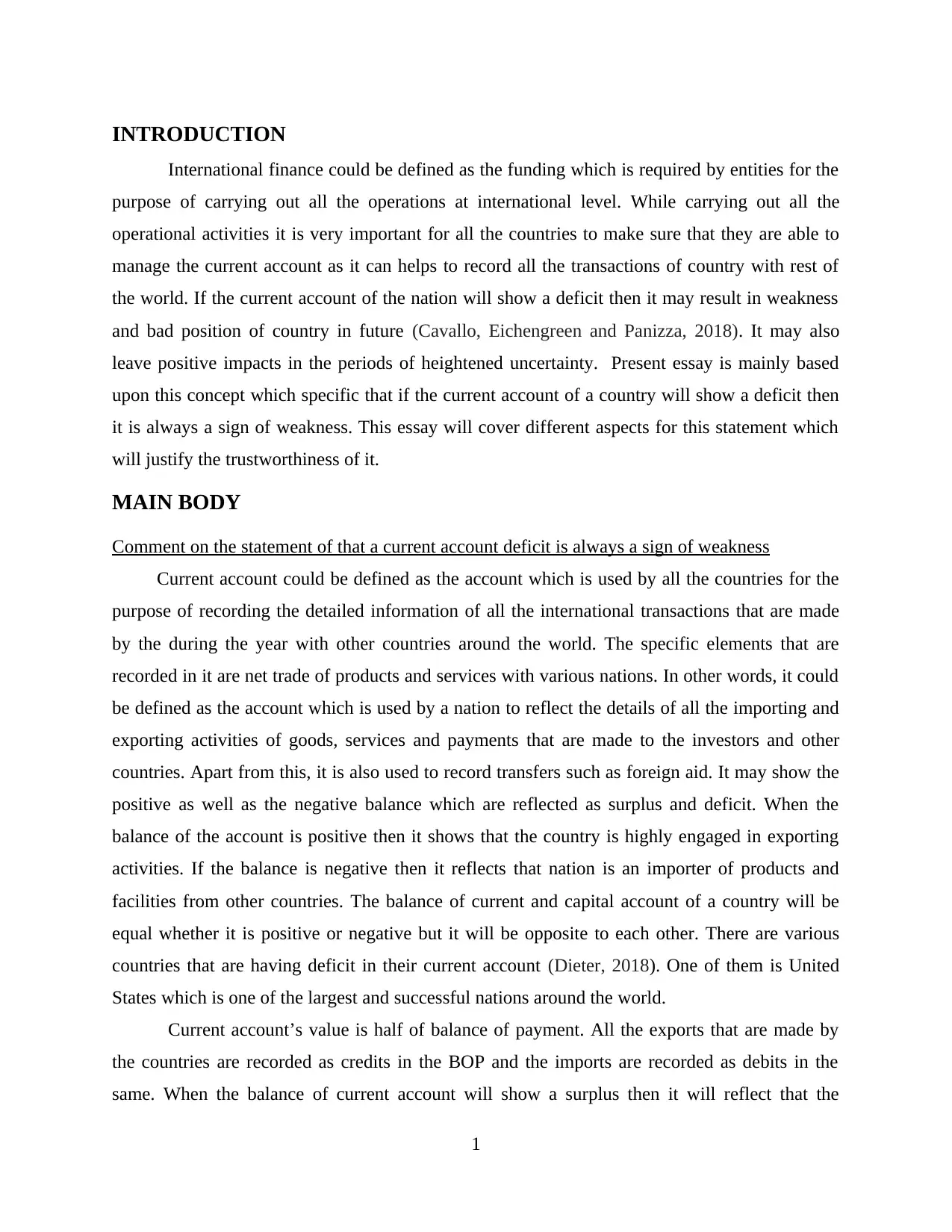
INTRODUCTION
International finance could be defined as the funding which is required by entities for the
purpose of carrying out all the operations at international level. While carrying out all the
operational activities it is very important for all the countries to make sure that they are able to
manage the current account as it can helps to record all the transactions of country with rest of
the world. If the current account of the nation will show a deficit then it may result in weakness
and bad position of country in future (Cavallo, Eichengreen and Panizza, 2018). It may also
leave positive impacts in the periods of heightened uncertainty. Present essay is mainly based
upon this concept which specific that if the current account of a country will show a deficit then
it is always a sign of weakness. This essay will cover different aspects for this statement which
will justify the trustworthiness of it.
MAIN BODY
Comment on the statement of that a current account deficit is always a sign of weakness
Current account could be defined as the account which is used by all the countries for the
purpose of recording the detailed information of all the international transactions that are made
by the during the year with other countries around the world. The specific elements that are
recorded in it are net trade of products and services with various nations. In other words, it could
be defined as the account which is used by a nation to reflect the details of all the importing and
exporting activities of goods, services and payments that are made to the investors and other
countries. Apart from this, it is also used to record transfers such as foreign aid. It may show the
positive as well as the negative balance which are reflected as surplus and deficit. When the
balance of the account is positive then it shows that the country is highly engaged in exporting
activities. If the balance is negative then it reflects that nation is an importer of products and
facilities from other countries. The balance of current and capital account of a country will be
equal whether it is positive or negative but it will be opposite to each other. There are various
countries that are having deficit in their current account (Dieter, 2018). One of them is United
States which is one of the largest and successful nations around the world.
Current account’s value is half of balance of payment. All the exports that are made by
the countries are recorded as credits in the BOP and the imports are recorded as debits in the
same. When the balance of current account will show a surplus then it will reflect that the
1
International finance could be defined as the funding which is required by entities for the
purpose of carrying out all the operations at international level. While carrying out all the
operational activities it is very important for all the countries to make sure that they are able to
manage the current account as it can helps to record all the transactions of country with rest of
the world. If the current account of the nation will show a deficit then it may result in weakness
and bad position of country in future (Cavallo, Eichengreen and Panizza, 2018). It may also
leave positive impacts in the periods of heightened uncertainty. Present essay is mainly based
upon this concept which specific that if the current account of a country will show a deficit then
it is always a sign of weakness. This essay will cover different aspects for this statement which
will justify the trustworthiness of it.
MAIN BODY
Comment on the statement of that a current account deficit is always a sign of weakness
Current account could be defined as the account which is used by all the countries for the
purpose of recording the detailed information of all the international transactions that are made
by the during the year with other countries around the world. The specific elements that are
recorded in it are net trade of products and services with various nations. In other words, it could
be defined as the account which is used by a nation to reflect the details of all the importing and
exporting activities of goods, services and payments that are made to the investors and other
countries. Apart from this, it is also used to record transfers such as foreign aid. It may show the
positive as well as the negative balance which are reflected as surplus and deficit. When the
balance of the account is positive then it shows that the country is highly engaged in exporting
activities. If the balance is negative then it reflects that nation is an importer of products and
facilities from other countries. The balance of current and capital account of a country will be
equal whether it is positive or negative but it will be opposite to each other. There are various
countries that are having deficit in their current account (Dieter, 2018). One of them is United
States which is one of the largest and successful nations around the world.
Current account’s value is half of balance of payment. All the exports that are made by
the countries are recorded as credits in the BOP and the imports are recorded as debits in the
same. When the balance of current account will show a surplus then it will reflect that the
1
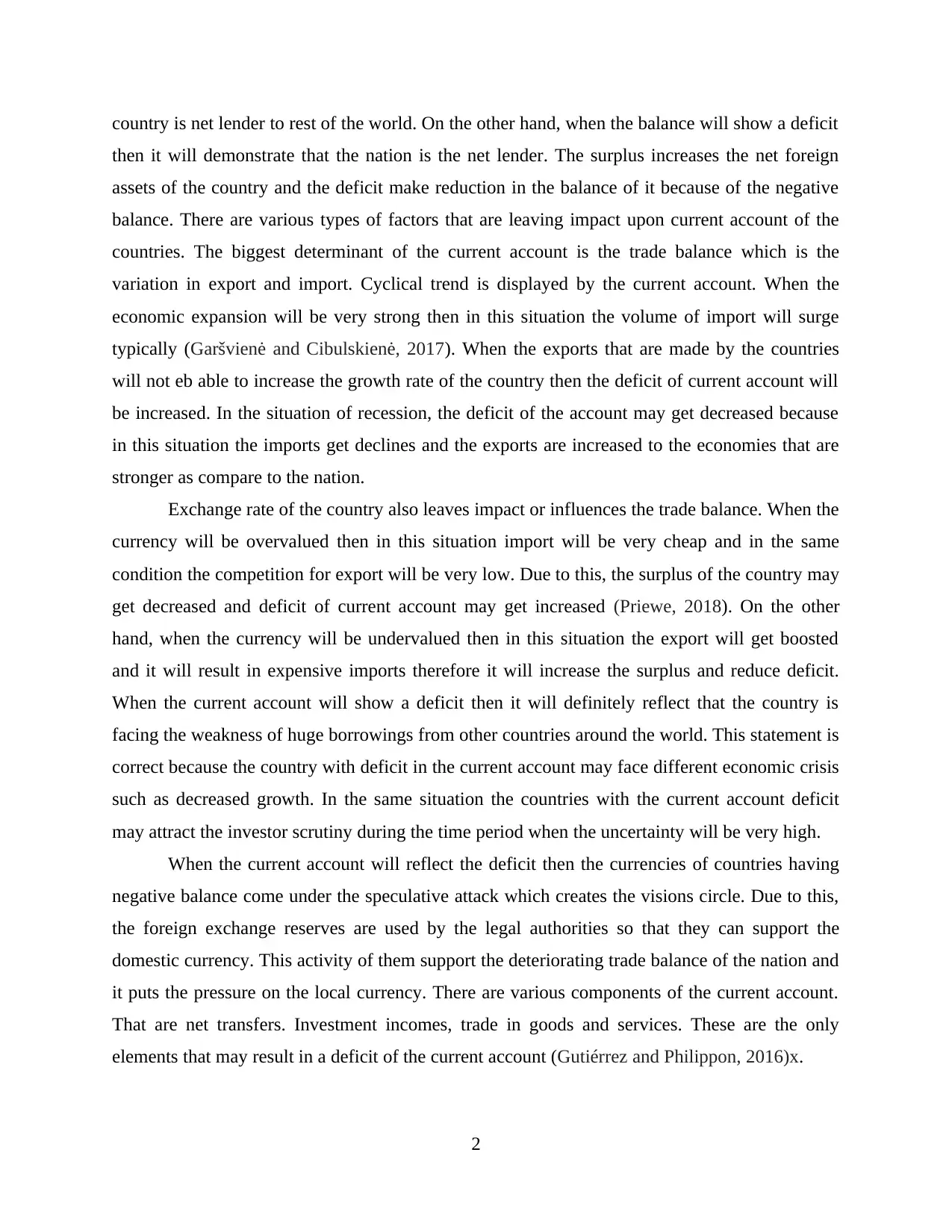
country is net lender to rest of the world. On the other hand, when the balance will show a deficit
then it will demonstrate that the nation is the net lender. The surplus increases the net foreign
assets of the country and the deficit make reduction in the balance of it because of the negative
balance. There are various types of factors that are leaving impact upon current account of the
countries. The biggest determinant of the current account is the trade balance which is the
variation in export and import. Cyclical trend is displayed by the current account. When the
economic expansion will be very strong then in this situation the volume of import will surge
typically (Garšvienė and Cibulskienė, 2017). When the exports that are made by the countries
will not eb able to increase the growth rate of the country then the deficit of current account will
be increased. In the situation of recession, the deficit of the account may get decreased because
in this situation the imports get declines and the exports are increased to the economies that are
stronger as compare to the nation.
Exchange rate of the country also leaves impact or influences the trade balance. When the
currency will be overvalued then in this situation import will be very cheap and in the same
condition the competition for export will be very low. Due to this, the surplus of the country may
get decreased and deficit of current account may get increased (Priewe, 2018). On the other
hand, when the currency will be undervalued then in this situation the export will get boosted
and it will result in expensive imports therefore it will increase the surplus and reduce deficit.
When the current account will show a deficit then it will definitely reflect that the country is
facing the weakness of huge borrowings from other countries around the world. This statement is
correct because the country with deficit in the current account may face different economic crisis
such as decreased growth. In the same situation the countries with the current account deficit
may attract the investor scrutiny during the time period when the uncertainty will be very high.
When the current account will reflect the deficit then the currencies of countries having
negative balance come under the speculative attack which creates the visions circle. Due to this,
the foreign exchange reserves are used by the legal authorities so that they can support the
domestic currency. This activity of them support the deteriorating trade balance of the nation and
it puts the pressure on the local currency. There are various components of the current account.
That are net transfers. Investment incomes, trade in goods and services. These are the only
elements that may result in a deficit of the current account (Gutiérrez and Philippon, 2016)x.
2
then it will demonstrate that the nation is the net lender. The surplus increases the net foreign
assets of the country and the deficit make reduction in the balance of it because of the negative
balance. There are various types of factors that are leaving impact upon current account of the
countries. The biggest determinant of the current account is the trade balance which is the
variation in export and import. Cyclical trend is displayed by the current account. When the
economic expansion will be very strong then in this situation the volume of import will surge
typically (Garšvienė and Cibulskienė, 2017). When the exports that are made by the countries
will not eb able to increase the growth rate of the country then the deficit of current account will
be increased. In the situation of recession, the deficit of the account may get decreased because
in this situation the imports get declines and the exports are increased to the economies that are
stronger as compare to the nation.
Exchange rate of the country also leaves impact or influences the trade balance. When the
currency will be overvalued then in this situation import will be very cheap and in the same
condition the competition for export will be very low. Due to this, the surplus of the country may
get decreased and deficit of current account may get increased (Priewe, 2018). On the other
hand, when the currency will be undervalued then in this situation the export will get boosted
and it will result in expensive imports therefore it will increase the surplus and reduce deficit.
When the current account will show a deficit then it will definitely reflect that the country is
facing the weakness of huge borrowings from other countries around the world. This statement is
correct because the country with deficit in the current account may face different economic crisis
such as decreased growth. In the same situation the countries with the current account deficit
may attract the investor scrutiny during the time period when the uncertainty will be very high.
When the current account will reflect the deficit then the currencies of countries having
negative balance come under the speculative attack which creates the visions circle. Due to this,
the foreign exchange reserves are used by the legal authorities so that they can support the
domestic currency. This activity of them support the deteriorating trade balance of the nation and
it puts the pressure on the local currency. There are various components of the current account.
That are net transfers. Investment incomes, trade in goods and services. These are the only
elements that may result in a deficit of the current account (Gutiérrez and Philippon, 2016)x.
2
Secure Best Marks with AI Grader
Need help grading? Try our AI Grader for instant feedback on your assignments.
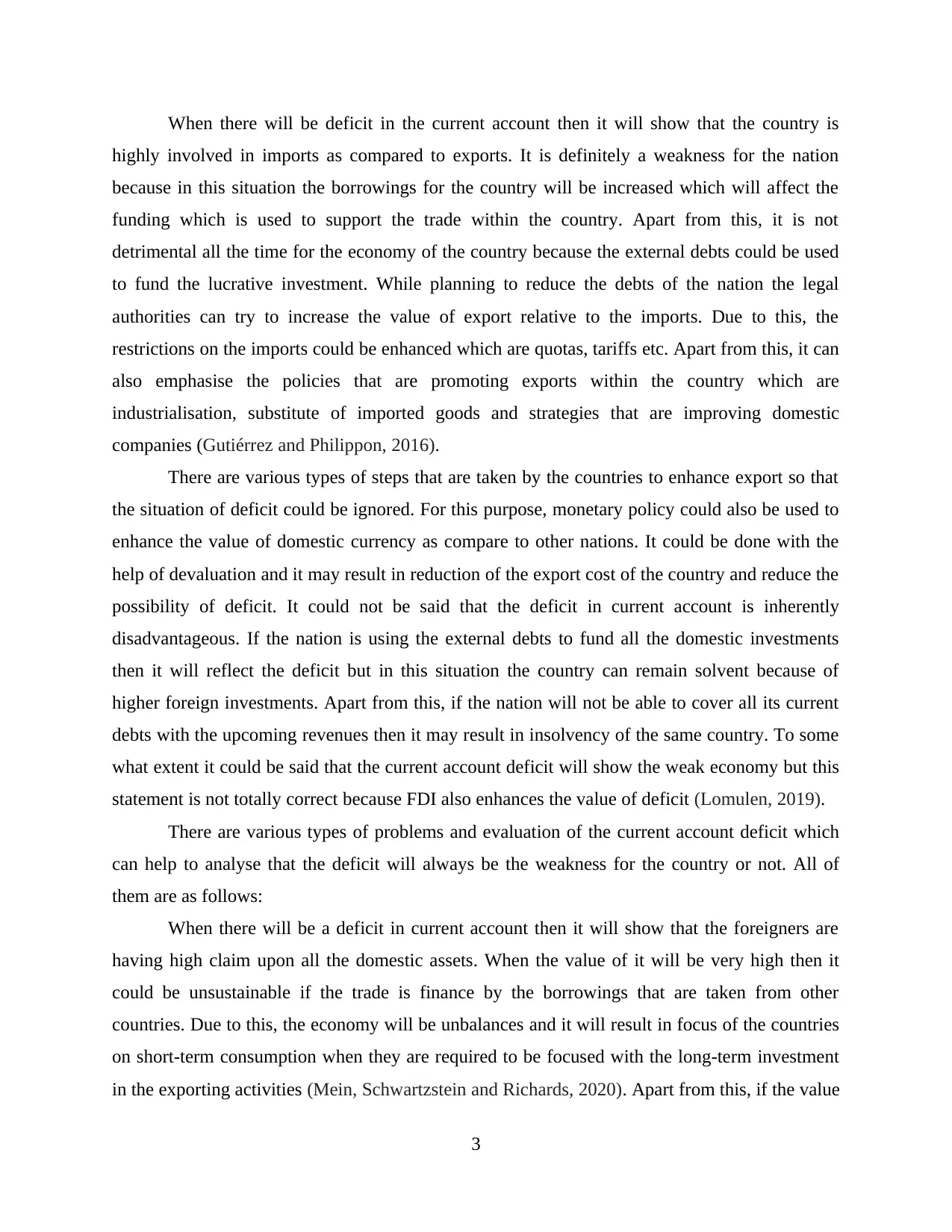
When there will be deficit in the current account then it will show that the country is
highly involved in imports as compared to exports. It is definitely a weakness for the nation
because in this situation the borrowings for the country will be increased which will affect the
funding which is used to support the trade within the country. Apart from this, it is not
detrimental all the time for the economy of the country because the external debts could be used
to fund the lucrative investment. While planning to reduce the debts of the nation the legal
authorities can try to increase the value of export relative to the imports. Due to this, the
restrictions on the imports could be enhanced which are quotas, tariffs etc. Apart from this, it can
also emphasise the policies that are promoting exports within the country which are
industrialisation, substitute of imported goods and strategies that are improving domestic
companies (Gutiérrez and Philippon, 2016).
There are various types of steps that are taken by the countries to enhance export so that
the situation of deficit could be ignored. For this purpose, monetary policy could also be used to
enhance the value of domestic currency as compare to other nations. It could be done with the
help of devaluation and it may result in reduction of the export cost of the country and reduce the
possibility of deficit. It could not be said that the deficit in current account is inherently
disadvantageous. If the nation is using the external debts to fund all the domestic investments
then it will reflect the deficit but in this situation the country can remain solvent because of
higher foreign investments. Apart from this, if the nation will not be able to cover all its current
debts with the upcoming revenues then it may result in insolvency of the same country. To some
what extent it could be said that the current account deficit will show the weak economy but this
statement is not totally correct because FDI also enhances the value of deficit (Lomulen, 2019).
There are various types of problems and evaluation of the current account deficit which
can help to analyse that the deficit will always be the weakness for the country or not. All of
them are as follows:
When there will be a deficit in current account then it will show that the foreigners are
having high claim upon all the domestic assets. When the value of it will be very high then it
could be unsustainable if the trade is finance by the borrowings that are taken from other
countries. Due to this, the economy will be unbalances and it will result in focus of the countries
on short-term consumption when they are required to be focused with the long-term investment
in the exporting activities (Mein, Schwartzstein and Richards, 2020). Apart from this, if the value
3
highly involved in imports as compared to exports. It is definitely a weakness for the nation
because in this situation the borrowings for the country will be increased which will affect the
funding which is used to support the trade within the country. Apart from this, it is not
detrimental all the time for the economy of the country because the external debts could be used
to fund the lucrative investment. While planning to reduce the debts of the nation the legal
authorities can try to increase the value of export relative to the imports. Due to this, the
restrictions on the imports could be enhanced which are quotas, tariffs etc. Apart from this, it can
also emphasise the policies that are promoting exports within the country which are
industrialisation, substitute of imported goods and strategies that are improving domestic
companies (Gutiérrez and Philippon, 2016).
There are various types of steps that are taken by the countries to enhance export so that
the situation of deficit could be ignored. For this purpose, monetary policy could also be used to
enhance the value of domestic currency as compare to other nations. It could be done with the
help of devaluation and it may result in reduction of the export cost of the country and reduce the
possibility of deficit. It could not be said that the deficit in current account is inherently
disadvantageous. If the nation is using the external debts to fund all the domestic investments
then it will reflect the deficit but in this situation the country can remain solvent because of
higher foreign investments. Apart from this, if the nation will not be able to cover all its current
debts with the upcoming revenues then it may result in insolvency of the same country. To some
what extent it could be said that the current account deficit will show the weak economy but this
statement is not totally correct because FDI also enhances the value of deficit (Lomulen, 2019).
There are various types of problems and evaluation of the current account deficit which
can help to analyse that the deficit will always be the weakness for the country or not. All of
them are as follows:
When there will be a deficit in current account then it will show that the foreigners are
having high claim upon all the domestic assets. When the value of it will be very high then it
could be unsustainable if the trade is finance by the borrowings that are taken from other
countries. Due to this, the economy will be unbalances and it will result in focus of the countries
on short-term consumption when they are required to be focused with the long-term investment
in the exporting activities (Mein, Schwartzstein and Richards, 2020). Apart from this, if the value
3
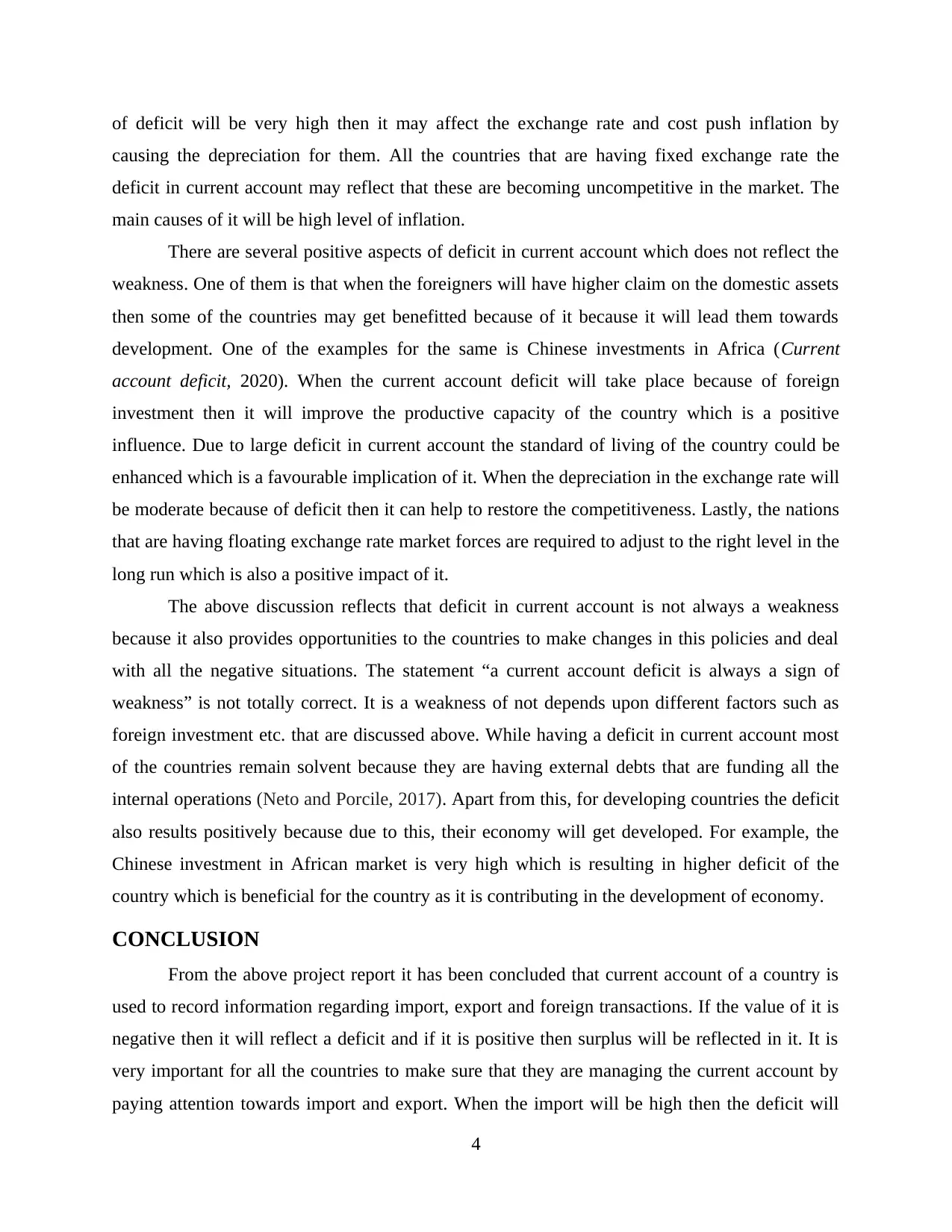
of deficit will be very high then it may affect the exchange rate and cost push inflation by
causing the depreciation for them. All the countries that are having fixed exchange rate the
deficit in current account may reflect that these are becoming uncompetitive in the market. The
main causes of it will be high level of inflation.
There are several positive aspects of deficit in current account which does not reflect the
weakness. One of them is that when the foreigners will have higher claim on the domestic assets
then some of the countries may get benefitted because of it because it will lead them towards
development. One of the examples for the same is Chinese investments in Africa (Current
account deficit, 2020). When the current account deficit will take place because of foreign
investment then it will improve the productive capacity of the country which is a positive
influence. Due to large deficit in current account the standard of living of the country could be
enhanced which is a favourable implication of it. When the depreciation in the exchange rate will
be moderate because of deficit then it can help to restore the competitiveness. Lastly, the nations
that are having floating exchange rate market forces are required to adjust to the right level in the
long run which is also a positive impact of it.
The above discussion reflects that deficit in current account is not always a weakness
because it also provides opportunities to the countries to make changes in this policies and deal
with all the negative situations. The statement “a current account deficit is always a sign of
weakness” is not totally correct. It is a weakness of not depends upon different factors such as
foreign investment etc. that are discussed above. While having a deficit in current account most
of the countries remain solvent because they are having external debts that are funding all the
internal operations (Neto and Porcile, 2017). Apart from this, for developing countries the deficit
also results positively because due to this, their economy will get developed. For example, the
Chinese investment in African market is very high which is resulting in higher deficit of the
country which is beneficial for the country as it is contributing in the development of economy.
CONCLUSION
From the above project report it has been concluded that current account of a country is
used to record information regarding import, export and foreign transactions. If the value of it is
negative then it will reflect a deficit and if it is positive then surplus will be reflected in it. It is
very important for all the countries to make sure that they are managing the current account by
paying attention towards import and export. When the import will be high then the deficit will
4
causing the depreciation for them. All the countries that are having fixed exchange rate the
deficit in current account may reflect that these are becoming uncompetitive in the market. The
main causes of it will be high level of inflation.
There are several positive aspects of deficit in current account which does not reflect the
weakness. One of them is that when the foreigners will have higher claim on the domestic assets
then some of the countries may get benefitted because of it because it will lead them towards
development. One of the examples for the same is Chinese investments in Africa (Current
account deficit, 2020). When the current account deficit will take place because of foreign
investment then it will improve the productive capacity of the country which is a positive
influence. Due to large deficit in current account the standard of living of the country could be
enhanced which is a favourable implication of it. When the depreciation in the exchange rate will
be moderate because of deficit then it can help to restore the competitiveness. Lastly, the nations
that are having floating exchange rate market forces are required to adjust to the right level in the
long run which is also a positive impact of it.
The above discussion reflects that deficit in current account is not always a weakness
because it also provides opportunities to the countries to make changes in this policies and deal
with all the negative situations. The statement “a current account deficit is always a sign of
weakness” is not totally correct. It is a weakness of not depends upon different factors such as
foreign investment etc. that are discussed above. While having a deficit in current account most
of the countries remain solvent because they are having external debts that are funding all the
internal operations (Neto and Porcile, 2017). Apart from this, for developing countries the deficit
also results positively because due to this, their economy will get developed. For example, the
Chinese investment in African market is very high which is resulting in higher deficit of the
country which is beneficial for the country as it is contributing in the development of economy.
CONCLUSION
From the above project report it has been concluded that current account of a country is
used to record information regarding import, export and foreign transactions. If the value of it is
negative then it will reflect a deficit and if it is positive then surplus will be reflected in it. It is
very important for all the countries to make sure that they are managing the current account by
paying attention towards import and export. When the import will be high then the deficit will
4
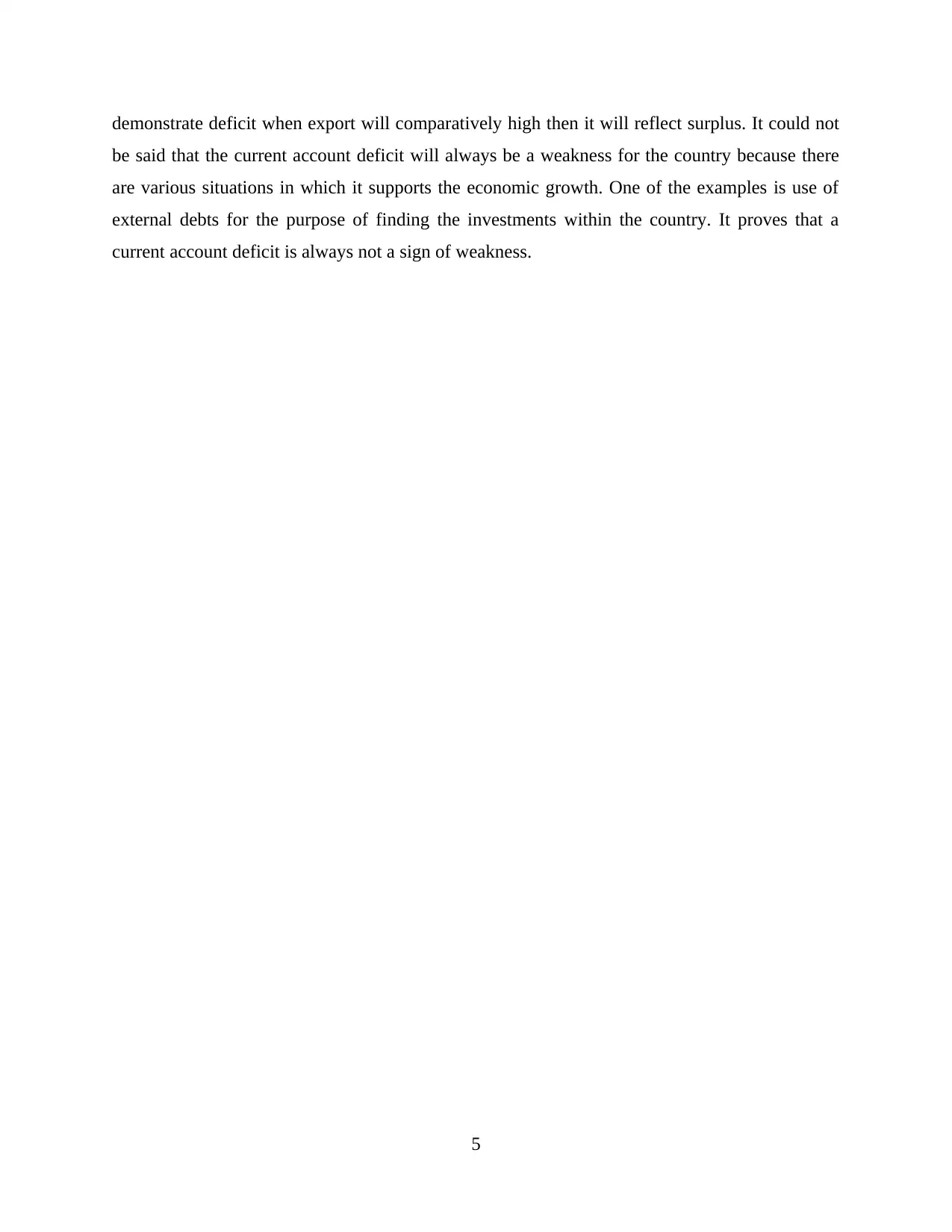
demonstrate deficit when export will comparatively high then it will reflect surplus. It could not
be said that the current account deficit will always be a weakness for the country because there
are various situations in which it supports the economic growth. One of the examples is use of
external debts for the purpose of finding the investments within the country. It proves that a
current account deficit is always not a sign of weakness.
5
be said that the current account deficit will always be a weakness for the country because there
are various situations in which it supports the economic growth. One of the examples is use of
external debts for the purpose of finding the investments within the country. It proves that a
current account deficit is always not a sign of weakness.
5
Paraphrase This Document
Need a fresh take? Get an instant paraphrase of this document with our AI Paraphraser
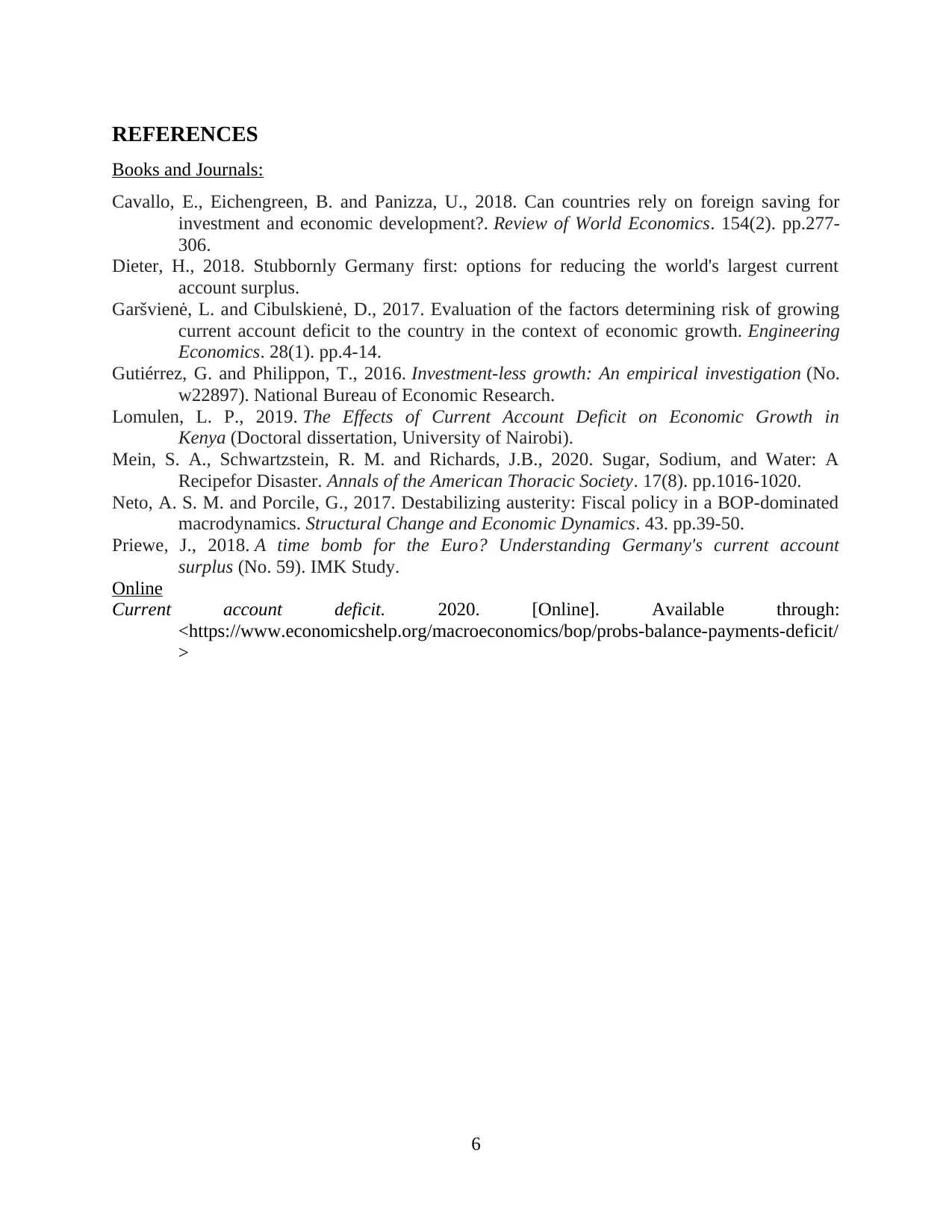
REFERENCES
Books and Journals:
Cavallo, E., Eichengreen, B. and Panizza, U., 2018. Can countries rely on foreign saving for
investment and economic development?. Review of World Economics. 154(2). pp.277-
306.
Dieter, H., 2018. Stubbornly Germany first: options for reducing the world's largest current
account surplus.
Garšvienė, L. and Cibulskienė, D., 2017. Evaluation of the factors determining risk of growing
current account deficit to the country in the context of economic growth. Engineering
Economics. 28(1). pp.4-14.
Gutiérrez, G. and Philippon, T., 2016. Investment-less growth: An empirical investigation (No.
w22897). National Bureau of Economic Research.
Lomulen, L. P., 2019. The Effects of Current Account Deficit on Economic Growth in
Kenya (Doctoral dissertation, University of Nairobi).
Mein, S. A., Schwartzstein, R. M. and Richards, J.B., 2020. Sugar, Sodium, and Water: A
Recipefor Disaster. Annals of the American Thoracic Society. 17(8). pp.1016-1020.
Neto, A. S. M. and Porcile, G., 2017. Destabilizing austerity: Fiscal policy in a BOP-dominated
macrodynamics. Structural Change and Economic Dynamics. 43. pp.39-50.
Priewe, J., 2018. A time bomb for the Euro? Understanding Germany's current account
surplus (No. 59). IMK Study.
Online
Current account deficit. 2020. [Online]. Available through:
<https://www.economicshelp.org/macroeconomics/bop/probs-balance-payments-deficit/
>
6
Books and Journals:
Cavallo, E., Eichengreen, B. and Panizza, U., 2018. Can countries rely on foreign saving for
investment and economic development?. Review of World Economics. 154(2). pp.277-
306.
Dieter, H., 2018. Stubbornly Germany first: options for reducing the world's largest current
account surplus.
Garšvienė, L. and Cibulskienė, D., 2017. Evaluation of the factors determining risk of growing
current account deficit to the country in the context of economic growth. Engineering
Economics. 28(1). pp.4-14.
Gutiérrez, G. and Philippon, T., 2016. Investment-less growth: An empirical investigation (No.
w22897). National Bureau of Economic Research.
Lomulen, L. P., 2019. The Effects of Current Account Deficit on Economic Growth in
Kenya (Doctoral dissertation, University of Nairobi).
Mein, S. A., Schwartzstein, R. M. and Richards, J.B., 2020. Sugar, Sodium, and Water: A
Recipefor Disaster. Annals of the American Thoracic Society. 17(8). pp.1016-1020.
Neto, A. S. M. and Porcile, G., 2017. Destabilizing austerity: Fiscal policy in a BOP-dominated
macrodynamics. Structural Change and Economic Dynamics. 43. pp.39-50.
Priewe, J., 2018. A time bomb for the Euro? Understanding Germany's current account
surplus (No. 59). IMK Study.
Online
Current account deficit. 2020. [Online]. Available through:
<https://www.economicshelp.org/macroeconomics/bop/probs-balance-payments-deficit/
>
6
1 out of 8
Related Documents
Your All-in-One AI-Powered Toolkit for Academic Success.
+13062052269
info@desklib.com
Available 24*7 on WhatsApp / Email
![[object Object]](/_next/static/media/star-bottom.7253800d.svg)
Unlock your academic potential
© 2024 | Zucol Services PVT LTD | All rights reserved.





